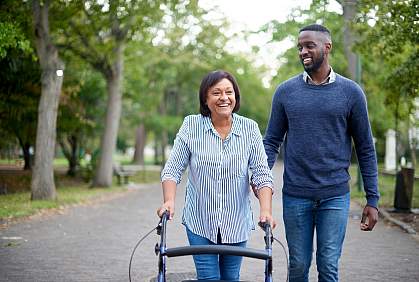You are here
July 28, 2020
Approach to prevent fall injuries no better than usual care
At a Glance
- In a large study, individualized plans designed to prevent serious injuries from falls among older adults who are at high risk didn’t improve upon usual care.
- Researchers will continue to test strategies to reduce serious fall injuries among older adults.

Falls can be serious, even deadly, for older adults. Each year, about 3 million adults 65 and older are treated in emergency departments nationwide for serious injuries from a fall. These injuries can result in disability and reduced quality of life. Fear of falling can lead older adults to be less physically and socially active.
Several factors can increase fall risk. Aging often brings changes to eyesight and reflexes. Muscle weakness, problems with balance, and foot problems can also increase the likelihood of a fall. Certain medications can contribute by causing dizziness and confusion. But falls are often preventable. Researchers have been studying strategies to prevent serious fall injuries among older adults.
A new study tested a fall injury intervention tailored to individuals and administered by specially trained nurses. The trial, called Strategies to Reduce Injuries and Develop Confidence in Elders (STRIDE), was funded by NIH’s National Institute on Aging (NIA) and the nonprofit Patient-Centered Outcomes Research Institute. Findings were published in the New England Journal of Medicine on July 9, 2020.
More than 5,400 participants, aged 70 and older, were enrolled at 86 primary care practices across 10 U.S. health care systems. The older adults who took part had been injured from a fall, had fallen at least two times in the previous year, or were afraid of falling because of difficulty walking or balancing.
The volunteers were first screened for fall injury risk factors. These included issues with walking and balance, falling hazards in the home, vision problems, problems with feet or shoes, weakened bones, certain medications, and low blood pressure when standing up.
Half the practices were randomly selected to use the tailored fall prevention plan. Specially trained nurses helped them to identify their risk factors and work to reduce one to three of them.
The other practices served as the control group. Participants received an informational pamphlet on falls and were encouraged to discuss fall prevention with their primary care doctors, who also received the risk factor screening results.
The researchers measured the length of time to the first serious fall injury. After a participant reported a serious injury, it was verified at the practice or through health records. The team looked at the intervention’s effectiveness over 20 months or more.
The overall rate of serious fall injuries in the trial was much lower (about 5%) than the team expected. While they hoped the fall prevention plan would reduce serious injuries, there was little difference in the rate of serious fall injuries between the two groups.
“The study reflects just how challenging it is to implement interventions to prevent fall injury in the real world,” says Dr. Shalender Bhasin of Brigham and Women’s Hospital, who co-led the study. “Measures that may reduce risk in the setting of a clinical trial can be less effective in the real world, where daily challenges such as being unable to afford transportation, or the cost of follow-up care, may delay or prevent access for patients.”
Past studies have shown that many falls in older adults can be prevented. Researchers will continue to explore the most effective ways to minimize serious fall injuries.
Related Links
- Benzodiazepine Often Used in Older People Despite Risks
- Tai Chi Increases Balance in Parkinson’s Patients
- Falls and Fall Prevention
- Balance Disorders
- STRIDE study
References: A Randomized Trial of a Multifactorial Strategy to Prevent Serious Fall Injuries. Bhasin S, Gill TM, Reuben DB, Latham NK, Ganz DA, Greene EJ, Dziura J, Basaria S, Gurwitz JH, Dykes PC, McMahon S, Storer TW, Gazarian P, Miller ME, Travison TG, Esserman D, Carnie MB, Goehring L, Fagan M, Greenspan SL, Alexander N, Wiggins J, Ko F, Siu AL, Volpi E, Wu AW, Rich J, Waring SC, Wallace RB, Casteel C, Resnick NM, Magaziner J, Charpentier P, Lu C, Araujo K, Rajeevan H, Meng C, Allore H, Brawley BF, Eder R, McGloin JM, Skokos EA, Duncan PW, Baker D, Boult C, Correa-de-Araujo R, Peduzzi P; STRIDE Trial Investigators. N Engl J Med. 2020 Jul 9;383(2):129-140. doi: 10.1056/NEJMoa2002183. PMID: 32640131.
Funding: NIH’s National Institute on Aging (NIA), National Center for Advancing Translational Sciences (NCATS), and National Center for Research Resources (NCRR); Patient-Centered Outcomes Research Institute; Brigham and Women’s Hospital; Harvard Clinical and Translational Science Center; Harvard University; Claude D. Pepper Older Americans Independence Centers at the University of California, Los Angeles; Yale University; Mount Sinai Medical Center; University of Texas Medical Branch; University of Michigan; University of Pittsburgh; Wake Forest University School of Medicine; Older Americans Independence Center National Coordinating Center; New York Academy of Medicine; University of Minnesota Clinical and Translational Science Institute; Michigan Medicine; University of Pittsburgh Medical Center.
